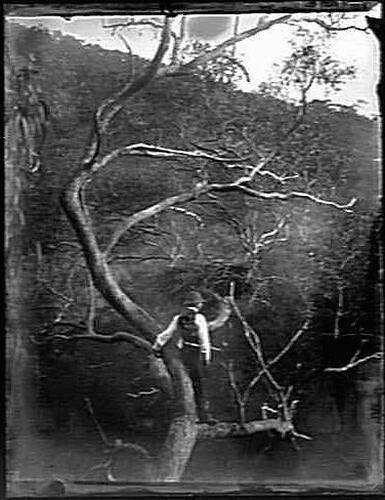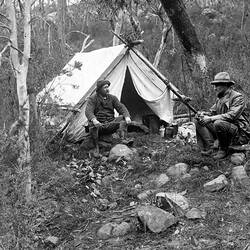The Wedge-tailed Eagle
Geographical Distribution - Whole of Australia and Tasmania.
Nest - Composed of dead sticks, and lined inside with such material as stringybark or grass and green branchlets. Usually the structure is exceedingly bulky, but woomewhat flat on the top; a fair-sized nest measuring about five or six feet across; inside, or egg cavity, about fourteen inches across by three or four inches deep. Situation, always a commanding one - a tall forest tree, or the forked limb of a tree at the bend of a river, or on a good mountain outlook. On the plains of the interior, where timber is absent, the nest is sometimes constructed of grass and placed on a bush.
Eggs - Clutch, two usually, sometimes one, rarely three; round in shape or round ovals; texture of shell coarse, surface dull and lustreless; colour, warmish-white, blotched and spotted with rusty-red or chestnut, intermingled with m dull cloudy purplish markings, which underlie the surface of the shell. In another paid the dull purplish markings predominate, one example having the whole of the smaller end covered with a large patch of dull or light purple. In a third clutch the dull markings predominate in one egg, while the other is so richly marbled or mottled with the rusty-red (in large patches in places) and purplish markings as to obliterate nearly the entire white surface. In some instances specimens have been known to be devoid of any markings, or one white egg in a pair.
Observations - The readers of AnthonyTrollope may regard the statement as Australian "blow" when I say that our Eagle, or as Australians call it, the Eagle Hawk, is larger than the famous Golden Eagle of Europe and elsewhere. Nevertheless, that is the fact, and any person who doubts may see both birds side by side in that well-ordered and instructive institution, the Zoological Garden, at Royal Park, Melbourne. It is somewhat remarkable that, in his Handbook, Gould has not recorded detailed dimensions for so large and important a bird as the Wedge-tailed Eagle. Diggles gives figures as follows: Total length, 38 inches; wing, 24 inches; tail, 17½ inches; bill, 2 ¾ inches; and tarsi or legs, 5 inches. The measurements of the Golden Eagle are:- Length, 32 inches; wing, 24 ½ inches; tail 13 inches. He does not give the expanse between tips of the wings, but I should say the measurement in an average specimen would be about six or seven feet. We are all familiar with the garb of the Wedge-tailed Eagle, which is dark-brown, almost black in some specimens. The difference between the brown and black plumage may be accounted for by age. The wedge-shaped tail, which first suggested the vernacular name of the bird, is generally black. The cere - i.e. the naked space between the feathers of the forehead and the bill proper - is yellowish, the bill yellowish-horn colour, passing into black at the tip, and feet also yellowish. Taken altogether, it is a noble and imposing bird, with searching hazel eyes set in a flat-crowned head.
The Wedge-tailed Eagle enjoys a wide range throughout the length and breadth of Australia and Tasmania. It is, however, becoming rare in parts, and in the near future may be as scarce as the Golden Eagle in Europe, consequent upon the war waged against the bird by squatters and others for sundry pastoral depredations, which the splendid bird is tempted by nature to commit. If we only reflect for a moment, we shall learn that the good Eagles perform considerably overbalances the harm they do.
Most of my experiences amongst Eagles' nests have been with the Messrs. Brittlebank in that romantic locality known as the Werribee Gorge, and the adjacent ironbark forest ranges beyond Bacchus Marsh, Victoria. Since the gold era, these wide localities have remained practically undisturbed for years. In some of the more secluded gullies we have seen trees supporting two or three nests, while at one favourite bend no less than six bulky structures were in sight, showing how long the birds had retained the same spot. Of course, only one or two would be the new nests; the others were abandoned aeries. Sometimes we proved that a particular nest was added to and used again season after season, and contained a plentiful amount of fur, evidently from rabbits and other animals consumed by the birds and young. The favourite situation for a nest or aerie is about thirty feed from the ground in a tree on the face of a steep hill, with the gully two hundred feet below and a commanding outlook on either side. Eagles' nests in the locality mentioned have been taken as early as the end of August and as late as 26th October, the birds appearing to commence to mate in March and April. However, in other localities, notably in Queensland, eggs have been taken as early as the 10th June.
In some instances the eggs were covered with branchlets or nest debris, showing the birds' caution in not leaving their eggs exposed, when the owners were absent. The nests Gould had opportunities of observing were placed on the most inaccessible trees. Although, during the months of August and Setpember, he repeatedly shot birds from their aeries in which there were eggs, he was unable to obtain them, not one but the aboriginals being capable of ascending such trees. But, during the year 1864, Gould received his first fine egg from Mr. George Angas, of South Australia.
Dr. Ramsay, writing to the Ibis, 1863, says:- 'The first eggs I obtained were taken in August, 1860, and were given me by Mr. James Ramsay, at Cardington, a station on the Bell River, near Molong. They were taken from a nest by a black-boy who had 'stepped' the tree. The nest was placed upon a fork near the end of one of the main branches of a large eucalyptus. It was fully seventy feet from the ground, and no easy task to get to it. The structure was about three-and-a-half feet high by four or five feet broad, and about eighteen inches deep, lined with tufts of grass and with down plucked from the breasts of the birds, upon which the eggs were placed.'
Resources
Transcribed Archibald James Campbell. Nests and Eggs of Australian Birds, including the Geographical Distribution of the Species and Popular Observations Thereon, Pawson & Brailsford, Sheffield, England, 1900. Page 11.
More Information
-
Keywords
-
Authors
-
Contributors
-
Article types



